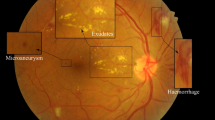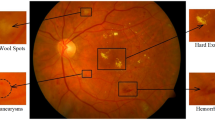Abstract
Recently, the attention mechanism has been effectively implemented in convolutional neural networks to boost performance of several computer vision tasks. Recognizing the potential of the attention mechanism in medical imaging, we present an end-to-end-trainable spatial Attention based convolutional neural network architecture for recognizing diabetic retinopathy severity level. Initially spatial representations of the fundus images are projected to reduced space using a stacked convolutional Auto-Encoder. In order to enhance discrimination in reduced space, the auto-encoder is jointly trained with the classifier in an end-to-end manner. Attention mechanism introduced in the classification module ensures high emphasis on lesion regions compared to the non-lesion regions. The proposed model is evaluated on two benchmark datasets, and the experimental outcomes indicate that joint training favors stability and complements the learned representations when used along with attention. The proposed approach outperforms several existing models by achieving an accuracy of 84.17%, 63.24% respectively on Kaggle APTOS19 and IDRiD datasets. In addition, ablation studies validate our contributions and the behavior of the proposed model on both the datasets.





Similar content being viewed by others
References
Amin J, Sharif M, Yasmin M (2016) A review on recent developments for detection of diabetic retinopathy. Scientifica, 2016
Bhandary SV, Rao KA (2018) Automated screening system for retinal health using bi-dimensional empirical mode decomposition and integrated index. Comput Biol Med 75:54–62
Bodapati JD, Shaik NS, Naralasetti V (2021) Deep convolution feature aggregation: an application to diabetic retinopathy severity level prediction, Signal Image and Video Processing, 1–8
Bodapati JD, Shaik NS, Naralasetti V (2021) Composite deep neural network with gated-attention mechanism for diabetic retinopathy severity classification. Journal of Ambient Intelligence and Humanized Computing
Bodapati JD, Shareef SN, Naralasetti V, Mundukur NB (2021) Msenet: Multi-modal squeeze-and-excitation network for brain tumor severity prediction, International Journal of Pattern Recognition and Artificial Intelligence, p 2157005
Bodapati JD, Veeranjaneyulu N (2019) Facial emotion recognition using deep cnn based features. Int Journal of Innovative Techn Exploring Eng, 2278–3075
Bodapati JD, Veeranjaneyulu N, Shareef SN, Hakak S, Bilal M, Maddikunta PKR, Jo O (2020) Blended multi-modal deep convnet features for diabetic retinopathy severity prediction. Electronics 9(6):914
Chen M, Shi X, Zhang Y, Wu D, Guizani M (2017) Deep features learning for medical image analysis with convolutional autoencoder neural network. IEEE Transactions on Big Data, 1–1
Chollet F (2017) Xception: Deep learning with depthwise separable convolutions. In: Proceedings of the IEEE conference on computer vision and pattern recognition (CVPR), p 07
Deng J, Dong W, Socher R, Li L-J, Li K, Fei-Fei L (2009) Imagenet: A large-scale hierarchical image database. In: 2009 IEEE conference on computer vision and pattern recognition. Ieee, pp 248–255
Dondeti V, Bodapati JD, Shareef SN, Naralasetti V (2020) Deep convolution features in non-linear embedding space for fundus image classification deep convolution features in non-linear embedding space for fundus image classification. Revue d’Intelligence Artificielle 34(3):307–313
Fang L, Wang C, Li S, Rabbani H, Chen X, Liu Z (2019) Attention to lesion: Lesion-aware convolutional neural network for retinal optical coherence tomography image classification. IEEE Trans Med Imaging 38(8):1959–1970
Fukui H, Hirakawa T, Yamashita T, Fujiyoshi H (2019) Attention branch network: Learning of attention mechanism for visual explanation. In: Proceedings of the IEEE/CVF conference on computer vision and pattern recognition (CVPR), p 06
Habib M, Welikala R, Hoppe A, Owen C, Rudnicka A, Barman S (2017) Detection of microaneurysms in retinal images using an ensemble classifier. Informatics in Medicine Unlocked 9:44–57
He A, Li T, Li N, Wang K, Fu H (2020) Cabnet: Category attention block for imbalanced diabetic retinopathy grading, IEEE Transactions on Medical Imaging
Hu J, Shen L, Sun G (2018) Squeeze-and-excitation networks. In: Proceedings of the IEEE conference on computer vision and pattern recognition (CVPR), p 06
Kaggle, Aptos (2019) Blindness detection challenge. https://www.kaggle.com/c/aptos2019-blindnes-detectionhttps://www.kaggle.com/c/aptos2019-blindnes- https://www.kaggle.com/c/aptos2019-blindnes-detectiondetection. Accessed: 2019-12-30
Kandel I, Castelli M (2020) Transfer learning with convolutional neural networks for diabetic retinopathy image classification. A review. Appl Sci 10(6):2021
Kassani SH, Kassani PH, Khazaeinezhad R, Wesolowski MJ, Schneider KA, Deters R (2019) Diabetic retinopathy classification using a modified xception architecture. In: IEEE International Symposium on Signal Processing and Information Technology (ISSPIT). IEEE, p 2019
Kaur N, Chatterjee S, Acharyya M, Kaur J, Kapoor N, Gupta S (2016) A supervised approach for automated detection of hemorrhages in retinal fundus images. In: 2016 5th International Conference on Wireless Networks and Embedded Systems (WECON). IEEE, pp 1–5
Li X, Hu X, Yu L, Zhu L, Fu C-W, Heng P-A (2019) Canet: cross-disease attention network for joint diabetic retinopathy and diabetic macular edema grading. IEEE Trans Med Imaging 39(5):1483–1493
Lin Z, Guo R, Wang Y, Wu B, Chen T, Wang W, Chen DZ, Wu J (2018) A framework for identifying diabetic retinopathy based on anti-noise detection and attention-based fusion. In: International conference on medical image computing and computer-assisted intervention. Springer, pp 74–82
Long S, Huang X, Chen Z, Pardhan S, Zheng D (2019) Automatic detection of hard exudates in color retinal images using dynamic threshold and svm classification: algorithm development and evaluation. BioMed research international, 2019
Luong M-T, Pham H, Manning CD (2015) Effective approaches to attention-based neural machine translation. In: International Conference on Learning Representations
Mansour RF (2018) Deep-learning-based automatic computer-aided diagnosis system for diabetic retinopathy. Biomed Eng Lett 8(1):41–57
Mateen M, Wen J, Song S, Huang Z, et al. (2019) Fundus image classification using vgg-19 architecture with pca and svd. Symmetry 11 (1):1
Math L, Fatima R (2021) Adaptive machine learning classification for diabetic retinopathy. Multimed Tools Appl 80(4):5173–5186
Mohammedhasan M, Uğuz H. (2020) A new early stage diabetic retinopathy diagnosis model using deep convolutional neural networks and principal component analysis. Traitement du Signal 37(5):711–722
Niemeijer M, Abramoff MD, Van Ginneken B (2009) Information fusion for diabetic retinopathy cad in digital color fundus photographs. IEEE Trans Med Imaging 28(5):775–785
Noushin E, Pourreza M, Masoudi K, Ghiasi Shirazi E (2019) Microaneurysm detection in fundus images using a two step convolution neural network. Biomed Eng Online 18(1):67
Poplin R, Varadarajan AV, Blumer K, Liu Y, McConnell MV, Corrado GS, Peng L, Webster DR (2018) Prediction of cardiovascular risk factors from retinal fundus photographs via deep learning. Nat Biomed Eng 2(3):158–164
Porwal P, Pachade S, Kamble R, Kokare M, Deshmukh G, Sahasrabuddhe V, Meriaudeau F (2018) Indian diabetic retinopathy image dataset (idrid): a database for diabetic retinopathy screening research. Data 3(3):25
Porwal P, Pachade S, Kokare M, Deshmukh G, Son J, Bae W, Liu L, Wang J, Liu X, Gao L et al (2020) Idrid: Diabetic retinopathy–segmentation and grading challenge. Med Image Anal 59:101561
Prentašić P, Lončarić S (2016) Detection of exudates in fundus photographs using deep neural networks and anatomical landmark detection fusion. Comput Methods Prog Biomed 137:281–292
Qureshi I, Ma J, Abbas Q (2019) Recent development on detection methods for the diagnosis of diabetic retinopathy. symmetry 11(6):749
Razzak MI, Naz S, Zaib A (2018) Deep learning for medical image processing: overview, challenges and the future. In: Classification in BioApps. Springer, pp 323–350
Riaz H, Park J, Choi H, Kim H, Kim J (2020) Deep and densely connected networks for classification of diabetic retinopathy. Diagnostics 10(1):24
Shaban M, Ogur Z, Mahmoud A, Switala A, Shalaby A, Abu Khalifeh H, Ghazal M, Fraiwan L, Giridharan G, Sandhu H et al (2020) A convolutional neural network for the screening and staging of diabetic retinopathy, vol 15
Sikder N, Masud M, Bairagi AK, Arif ASM, Nahid A.-A., Alhumyani HA (2021) Severity classification of diabetic retinopathy using an ensemble learning algorithm through analyzing retinal images. Symmetry 13(4):670
Stolte S, Fang R (2020) A survey on medical image analysis in diabetic retinopathy. Med Image Anal 64:101742
Thomas R, Halim S, Gurudas S, Sivaprasad S, Owens D (2019) Idf diabetes atlas: A review of studies utilising retinal photography on the global prevalence of diabetes related retinopathy between 2015 and 2018. Diabetes Res Clin Pract 157:107840
Wiering MA, Van der Ree MH, Embrechts M, Stollenga M, Meijster A, Nolte A, Schomaker L (2013) The neural support vector machine. In: BNAIC 2013: Proceedings of the 25th Benelux Conference on Artificial Intelligence. November 7-8, 2013 Delft University of Technology (TU Delft); under the auspices of the Benelux.. Delft, The Netherlands
Yang Y, Shang F, Wu B, Yang D, Wang L, Xu Y, Zhang W, Zhang T (2021) Robust collaborative learning of patch-level and image-level annotations for diabetic retinopathy grading from fundus image. IEEE Transactions on Cybernetics
Zhang X, Thibault G, Decencière E, Marcotegui B, Laÿ B., Danno R, Cazuguel G, Quellec G, Lamard M, Massin P et al (2014) Exudate detection in color retinal images for mass screening of diabetic retinopathy. Med Image Anal 18(7):1026–1043
Zhao Z, Zhang K, Hao X, Tian J, Chua MCH, Chen L, Xu X (2019) Bira-net: Bilinear attention net for diabetic retinopathy grading. In: 2019 IEEE International Conference on Image Processing (ICIP). IEEE, pp 1385–1389
Funding
No funding has been received for this work
Author information
Authors and Affiliations
Corresponding author
Additional information
Publisher’s note
Springer Nature remains neutral with regard to jurisdictional claims in published maps and institutional affiliations.
Rights and permissions
About this article
Cite this article
Bodapati, J.D. Stacked convolutional auto-encoder representations with spatial attention for efficient diabetic retinopathy diagnosis. Multimed Tools Appl 81, 32033–32056 (2022). https://doi.org/10.1007/s11042-022-12811-5
Received:
Revised:
Accepted:
Published:
Issue Date:
DOI: https://doi.org/10.1007/s11042-022-12811-5




